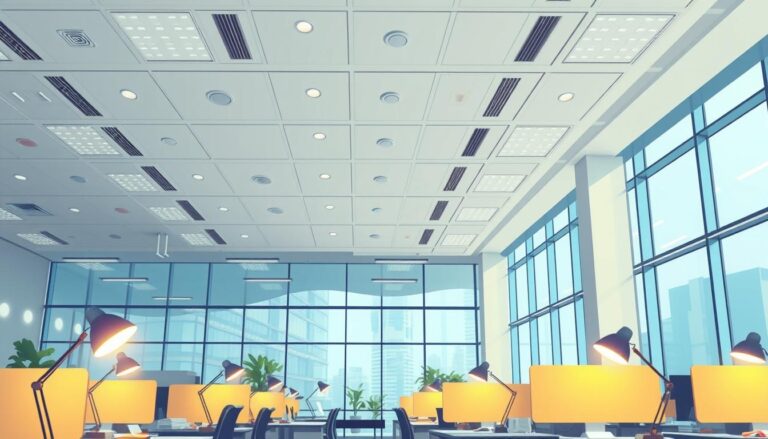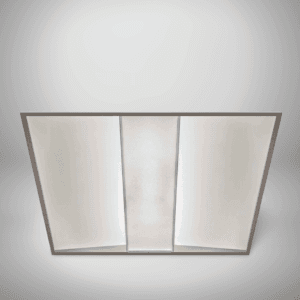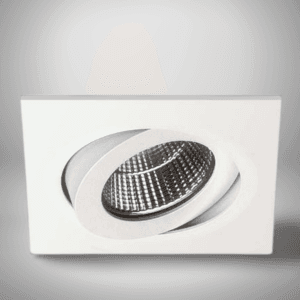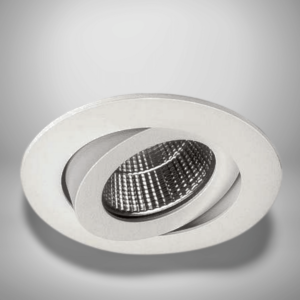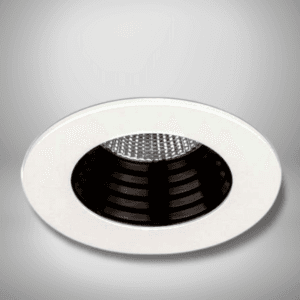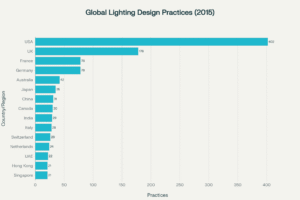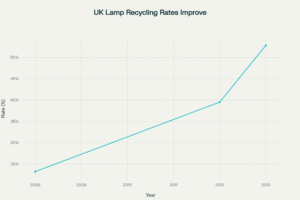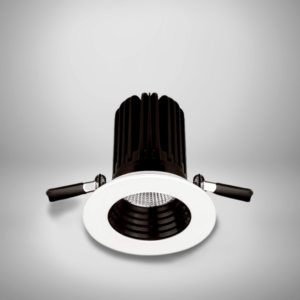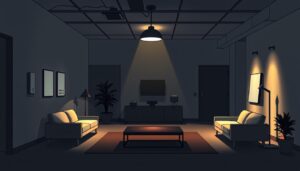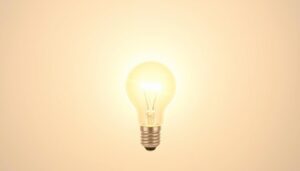Every day, your eyes process over 10 hours of digital information under artificial light—yet most of us pay more attention to our coffee brand than the lighting that impacts our entire workday.
The wrong lighting isn’t just an annoyance; it’s silently contributing to your afternoon headaches, diminished productivity, and that unexplained fatigue that sends you reaching for another espresso.
At Lumenloop, we’ve spent years studying how light shapes our workday experience. Drawing from cutting-edge research in chronobiology and workplace ergonomics, we’ve discovered that optimized lighting can reduce eye strain by up to 32% and enhance cognitive performance throughout the day. This isn’t just about illumination—it’s about engineering an environment where your eyes and mind work in perfect harmony.
Understanding the Importance of Eye-Friendly Office Lighting
Think of your eyes as Olympic athletes—they’re sprinting a marathon every day, processing thousands of micro-movements between screens, documents, and colleagues. But unlike athletes, we rarely give our eyes the elite-level support they deserve. The result? An epidemic of digital eye strain affecting 79% of office workers, with symptoms ranging from blurred vision to chronic neck pain.
But here’s the reality most lighting companies won’t tell you: the solution isn’t always about brightness. In fact, many offices are overlit with harsh, flickering fluorescents that create as many problems as they solve. The secret lies in understanding the delicate dance between direct and indirect lighting, colour temperature, and your body’s natural circadian rhythms.
Imagine a workspace where light adapts to your tasks—bright and invigorating for detail-oriented work, soft and supportive during creative sessions. A space where end-of-day headaches become a distant memory, and your eyes feel as fresh at 5 PM as they did at 9 AM. This isn’t a luxury—it’s a necessity for the modern workplace.
The Connection Between Lighting and Eye Health
Poor lighting can lead to a host of issues, from eye strain to headaches. Flicker and glare from outdated fluorescent lamps are common culprits. Studies show that prolonged exposure to harsh lighting can cause dryness and fatigue, making it harder to concentrate.
Experts recommend using LED bulbs with reduced flicker and glare. These options are not only energy-efficient but also easier on the eyes. Additionally, the right colour temperature can make a significant difference. Warm tones (around 3000K) are ideal for reducing strain during long work sessions.
Impacts on Productivity and Wellbeing
Lighting doesn’t just affect your eyes—it influences your overall wellbeing. Poor quality illumination can lead to reduced productivity and even mood swings and irritable behaviour. On the other hand, well-designed lighting can increase focus and create a more comfortable environment.
For example, the 20-20-20 rule is a simple yet effective way to reduce eye strain. Every 20 minutes, take a 20-second break to look at something 20 feet away. This practice, combined with the right lighting, can make a world of difference.
| Lighting Type | Benefits | Drawbacks |
|---|---|---|
| LED | Energy-efficient, reduced flicker, long lifespan | Higher upfront cost |
| Fluorescent | Affordable, bright | Flicker, glare, poor colour rendering |
| Incandescent | Warm light, inexpensive | Energy-inefficient, short lifespan |
By choosing the right lamp and bulb, you can create a workspace that supports your vision and enhances your efficiency.
Exploring Different Lighting Technologies in the Modern Office
Modern offices demand lighting solutions that blend technology with comfort. With so many options available, it’s essential to understand the strengths and weaknesses of each. From LED to incandescent and fluorescent, the right choice can make all the difference.
Comparing LED, Incandescent and Fluorescent Options
LED bulbs are a popular choice for their energy efficiency and long lifespan. They produce less heat and flicker, making them easier on the eye. While the upfront cost is higher, the savings over time are significant.
Incandescent lamps offer warm, natural light but are less energy-efficient. They’re often used in settings where colour accuracy is less critical. However, their short lifespan makes them less practical for modern offices.
Fluorescent lighting is bright and affordable but can cause glare and flicker, leading to eye strain. It’s a common choice for large spaces but may not be ideal for detailed tasks and certainly isn’t energy effecient.
What light is best for eyes in office? - Expert Recommendations
Expert insights reveal that the right lighting can transform your workspace into a haven of comfort and efficiency. We asked ophthalmologists and ergonomists to bring you actionable advice for minimising strain and enhancing productivity.
Insights from Ophthalmologists and Ergonomists
Harsh blue light emissions from screens and poorly designed lamps can lead to discomfort and fatigue. Ophthalmologists recommend using LED bulbs with warm white tones (around 3000K) to create a soothing environment.
Ergonomists also suggest incorporating adjustable desk lamps, like the Dyson Solarcycle Morph, which adapts to your tasks throughout the day. These solutions not only reduce strain but also improve focus during long work sessions.
Practical Considerations for Reducing Eye Strain
Here are some practical tips to optimise your workspace lighting:
- Use full spectrum lighting to enhance colour clarity and reduce glare.
- Opt for incandescent bulbs in areas where flicker-free illumination is essential.
- Position your lamp to avoid shadows and reflections on your computer screen.
Research shows that employees exposed to natural light report an 84% drop in eye strain and headaches. If natural light isn’t available, consider full-spectrum options like Chromalux® to mimic daylight.
| Lighting Type | Benefits | Drawbacks |
|---|---|---|
| LED | Energy-efficient, reduced flicker, long lifespan | High upfront cost |
| Incandescent | Warm light, flicker-free | Energy-inefficient, short lifespan |
| High CRI LED | Enhanced colour clarity, reduced glare | Higher cost |
The Lumenloop Advantage: Sustainable, High-Performance Solutions
We believe that sustainable lighting solutions should not only enhance your workspace but also protect your health and the planet. Our commitment to closing the loop on light waste drives every innovation we create. From energy-efficient LED bulbs to ergonomic designs, we’re redefining what it means to illuminate responsibly.
Our products are designed with both sustainability and performance in mind. By focusing on regenerative and refurbishable luminaires, we aim to eliminate lighting-related e-waste entirely.
Benefits of PAR IEEE 1789 Accredited Lighting
Lights with PAR IEEE 1789 accreditation offer significant health and comfort advantages by adhering to strict standards that minimize flicker-related health risks.
This important certification ensures that lighting products produce minimal stroboscopic effects, reducing the potential for headaches, eyestrain, and visual discomfort that can be caused by poor-quality LED lighting.
PAR IEEE 1789 accredited lights are particularly beneficial in environments requiring sustained focus, such as offices, healthcare facilities, and educational settings, as they help prevent flicker-induced neurological symptoms and visual fatigue.
Innovative Design and Energy Efficiency
What sets Lumenloop apart is our dedication to innovative design. Our luminaires are engineered to reduce eye strain and enhance comfort, making them ideal for long hours of work. Features like superior light dispersion and reduced blue light emissions ensure a healthier workspace.
Here’s how our solutions stand out:
- Energy Efficiency: Our LED bulbs use up to 75% less energy compared to traditional options, reducing operational costs significantly.
- Durability: With lifespans of up to 50,000 hours, our products require less frequent replacements, cutting maintenance costs by 25%.
- Comfort: Warm colour temperatures and flicker-free designs minimise eye strain, boosting productivity and wellbeing.
Our products meet rigorous standards for energy performance, ensuring they’re not only good for your health but also for your bottom line. By choosing Lumenloop, you’re investing in a brighter, more sustainable future.
| Feature | Lumenloop | Traditional Options |
|---|---|---|
| Energy Efficiency | Up to 75% savings | High energy consumption |
| Lifespan | 50,000 hours | 1,000 hours |
| Eye Comfort | Reduced flicker and glare | High flicker and glare |
Optimising Your Office Environment for Comfort and Eye Health
Creating a workspace that prioritises comfort and eye health starts with thoughtful lighting adjustments. At Lumenloop, we understand that the right setup can make a significant difference in reducing strain and enhancing productivity. Here’s how you can achieve an optimised office environment.
Customising Brightness and Colour Temperature
Adjusting the brightness and colour temperature of your light sources is crucial. For most office tasks, a temperature range of 4000K to 4500K is ideal. This range provides a bright, neutral light that mimics natural daylight, reducing strain during long hours of work.
Consider using LED bulbs with adjustable settings. These allow you to tailor the light to your specific needs, whether you’re focusing on detailed tasks or attending virtual meetings.
Effective Strategies to Minimise Glare
Glare from computer screens or harsh light sources can cause discomfort. To minimise this, position your lamp so it doesn’t reflect directly onto your screen. Using blinds or shades can also help control natural light levels.
Integrating Natural and Adaptable Lighting
Blending natural daylight with adaptable artificial lighting can significantly reduce eye strain. Position workstations to maximise exposure to natural light, which regulates bodily functions and boosts mood.
For areas with limited natural light, consider high CRI options. These mimic daylight and improve contrast, making them perfect for detailed tasks.
| Lighting Type | Benefits | Drawbacks |
|---|---|---|
| LED | Energy-efficient, adjustable, long lifespan | Higher upfront cost |
| Fluorescent | Bright, affordable | Flicker, glare |
| Natural Light | Boosts mood, regulates circadian rhythm | Dependent on window availability |
By customising your lighting setup, you can create a workspace that supports both your eye health and overall wellbeing.
Conclusion
Choosing the right bulb for your workspace can make a world of difference. It’s not just about brightness—it’s about creating a space that supports your health and reduces strain. From LED options to incandescent and fluorescent types, each has its strengths. Experts recommend warmer colour temperatures to ease eye discomfort during long hours.
At Lumenloop, we’re committed to delivering sustainable, high-performance solutions. Our lamps and bulbs are designed to balance innovation with comfort. By focusing on reducing flicker and glare, we help you stay productive without compromising your wellbeing.
We encourage you to review your current setup. Small changes, like switching to LED or adjusting temperature, can have a big impact. Visit our website for more tips or subscribe to our newsletter for expert advice. Let’s create a workspace that works for you.
FAQ
How does office lighting affect eye health?
Poor lighting can lead to eye strain, headaches, and fatigue. Using the right light source with appropriate colour temperature and brightness levels helps reduce these issues.
What type of bulb is most suitable for office environments?
LED bulbs are highly recommended due to their energy efficiency, long lifespan, and ability to mimic natural daylight, which is easier on the eyes.
How can I reduce eye strain from computer screens?
Adjust the screen brightness to match the ambient lighting, use anti-glare filters, and take regular breaks to rest your eyes. Pairing these with proper task lighting can make a big difference.
Is blue light harmful in office settings?
Excessive blue light from screens and certain bulbs can disrupt sleep patterns and cause eye strain. Opt for LEDs with lower blue light emissions or use blue light-blocking glasses.
What is the ideal colour temperature for office lighting?
A colour temperature of 4000K to 5000K is ideal as it provides a neutral, daylight-like glow that enhances focus and reduces strain.
How does natural light impact office productivity?
Natural light boosts mood, energy, and productivity. Where possible, position desks near windows and use adaptive lighting to complement daylight.
Are fluorescent lights a good option for offices?
While fluorescent lights are energy-efficient, they can flicker and emit harsh light, leading to discomfort. LEDs are a better alternative for eye-friendly illumination.
How can I minimise glare in my workspace?
Use diffused lighting, position lamps away from reflective surfaces, and adjust screen angles to reduce glare and improve comfort.
What role does lighting design play in office health?
Proper lighting design ensures even distribution, reduces shadows, and balances ambient and task lighting, creating a healthier and more productive workspace.
Why choose Lumenloop for office lighting solutions?
We focus on sustainable, high-performance lighting that prioritises eye health, energy efficiency, and innovative design to enhance your office environment.
